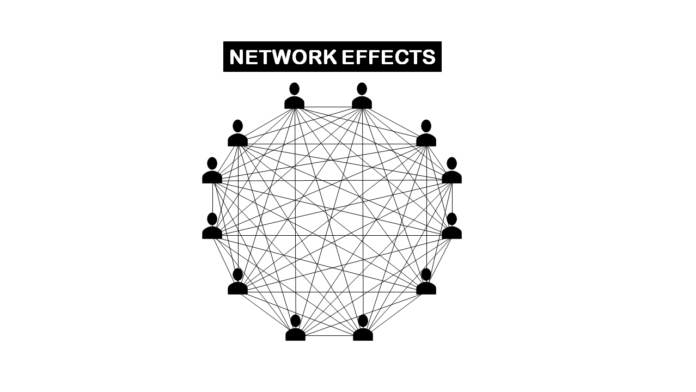What’s the Big Deal About Network Effects?
Ever noticed how some platforms seem to grow effortlessly, while others struggle to gain traction? The secret often lies in network effects, the idea that a product or service becomes more valuable as more people use it. Think about WhatsApp, Uber, or Airbnb. The more users they get, the better the experience becomes for everyone.
If you’re building a business, especially in the digital space, tapping into network effects can set you up for massive, self-sustaining growth. But how do you actually make it happen? Let’s break it down.
Find the Right Type of Network Effect for Your Business
Not all network effects work the same way, and understanding which type applies to your business is key to structuring your growth strategy. Direct network effects occur when the value of a product increases simply because more people use it. Social media platforms like Facebook, Instagram, and LinkedIn thrive on this principle—the more users they attract, the more valuable the platform becomes for everyone.
Indirect network effects happen when a growing user base attracts complementary products or services, which in turn enhance the experience for users. A great example of this is the iPhone and its App Store. As more people started using iPhones, developers were incentivized to create apps, which in turn made iPhones even more useful.
Then there are two-sided network effects, which apply to marketplaces and platforms that connect two different user groups. Platforms like Uber, Airbnb, and Amazon benefit from this model because as one side (drivers, hosts, or sellers) grows, the other side (riders, travelers, or buyers) finds more value in the platform. Recognizing which network effect applies to your business will determine how you should attract and retain users.
Solve the “Cold Start” Problem
One of the biggest challenges in creating a network effect is getting it started. A network with only a handful of users doesn’t provide much value, making it hard to attract new users. This is called the “cold start” problem, and overcoming it is crucial to success.
One way to solve this is by incentivizing early adopters. Many successful platforms initially offered financial rewards or free perks to get people to sign up. PayPal, for example, literally gave people money to join and refer their friends. Uber used a similar approach by offering significant bonuses to drivers and discounts to riders.
Another strategy is to create a sense of exclusivity. Making something feel scarce or invite-only can drive demand and make people want to join. Clubhouse, the audio-based social platform, leveraged this idea by launching as an invite-only app, making it seem like an elite, must-have experience.
A third approach is to integrate with existing platforms that already have users. If people are already using a certain app or service, making your product easily accessible through that platform can be a great way to get traction. For example, Zoom integrated with Slack and Microsoft Teams, allowing people to access its services without leaving the tools they were already using.
Make It Easy to Share and Engage
A strong network effect requires users to keep engaging with the platform and bringing others in. This means designing your product in a way that encourages social interaction, sharing, and participation.
Referral programs are one of the most effective ways to achieve this. Dropbox, for example, saw massive growth because it gave users extra storage space for every friend they invited. This made people excited to spread the word, which helped Dropbox scale quickly.
Gamification is another powerful tool. Apps like Duolingo use points, streaks, and leaderboards to keep users engaged. When people feel a sense of progress or competition, they are more likely to stay active and encourage others to join.
User-generated content is perhaps the strongest driver of organic growth. Platforms like TikTok, Instagram, and YouTube thrive because users create content that attracts new users. When people share videos, photos, or posts, they essentially become unpaid marketers, helping the platform grow effortlessly.
Keep Users Hooked So They Don’t Leave
Attracting users is one thing, but keeping them engaged and preventing them from switching to a competitor is just as important. If users can easily move to another platform without losing anything, your network effect may not be strong enough.
One way to increase stickiness is through data and profile lock-in. LinkedIn is a great example of this. Over time, users build up connections, endorsements, and career history that would be difficult to replicate on another platform. The more they invest in their profile, the harder it becomes to leave.
Another approach is to expand your ecosystem so users get multiple services in one place. Apple is a master at this—once you start using an iPhone, you’re more likely to get an Apple Watch, MacBook, and AirPods because they all work seamlessly together. The more products you own, the harder it is to switch to another ecosystem.
Finally, strong communities can create a sense of belonging that keeps users loyal. Reddit, for example, is full of niche communities where people develop relationships and engage in discussions they can’t find elsewhere. Once users feel like they are part of a group, they are far less likely to leave.
Use AI to Make the Experience Better
Artificial intelligence can enhance network effects by making the user experience more personalized, relevant, and engaging. AI-driven recommendation engines, like those used by YouTube and Netflix, analyze user behavior to suggest content that keeps people coming back. The more people engage, the better the AI gets at predicting what they like, reinforcing the network effect.
AI-powered customer support and chatbots also help keep users engaged by providing instant assistance. Companies like OpenAI, through tools like ChatGPT, use AI to answer questions, solve problems, and keep conversations flowing, which enhances user experience and retention.
Predictive analytics is another way AI strengthens network effects. Platforms like Spotify analyze listening habits to create customized playlists that make users feel like the service understands them personally. The more personalized the experience, the more likely users are to stick around.
Monetize Without Pushing Users Away
Once a network effect takes hold, monetizing the platform is the next challenge. If you introduce pricing too early or too aggressively, you might drive away potential users before the network reaches its full potential.
One of the best ways to balance growth and monetization is through freemium models. Spotify allows free users to listen to music with ads, but charges for a premium experience with additional features. This allows them to attract a large audience while converting the most engaged users into paying customers.
Transaction fees are another common model. Platforms like Airbnb and eBay allow users to list for free but take a percentage of transactions. This way, they only make money when users do, creating a win-win situation.
Enterprise solutions provide another revenue stream without interfering with the core user base. LinkedIn, for instance, generates most of its revenue from recruiters and businesses rather than from individual users, allowing professionals to continue using the platform for free while monetizing the companies that need access to them.
Building a network effect isn’t just about getting more users—it’s about creating value that grows with each new person who joins. Whether you’re launching a startup or scaling an existing business, focus on making it easy to join, share, and stay. When done right, network effects create a flywheel that accelerates growth and sustains success over time.
At Atlantic Review, we dive deep into digital transformation and business strategy. If you’re building something that leverages network effects, let’s discuss—drop a comment or share your thoughts!

